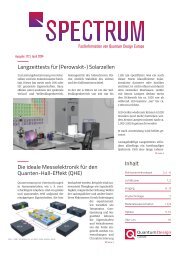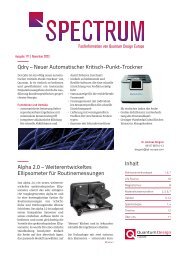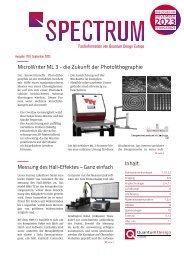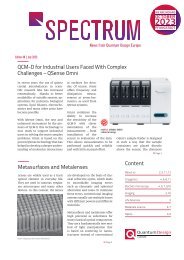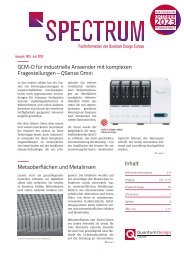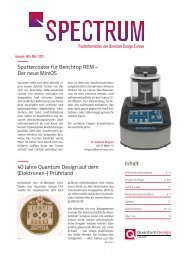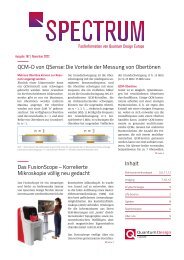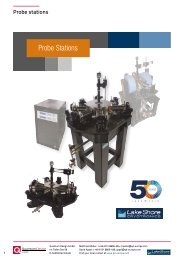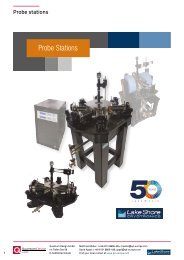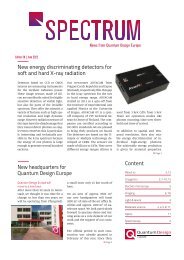Spectrum E39
You also want an ePaper? Increase the reach of your titles
YUMPU automatically turns print PDFs into web optimized ePapers that Google loves.
Imaging/Crogenics<br />
boratory XAS using Sigray's<br />
QuantumLeap system can provide<br />
synchrotron-like results for<br />
high-energy XAS analysis. Using<br />
well-established software, measurements<br />
on a Zr foil were converted<br />
into quantitative results<br />
(bond length, coordination number,<br />
and local atomistic disorder).<br />
[1] B. Ravel and M. Newville, ATHENA,<br />
ARTEMIS, HEPHAESTUS: data analysis<br />
for X-ray absorption spectroscopy<br />
using IFEFFIT, Journal of Synchrotron<br />
Radiation 12, 537-541 (2005).<br />
Please contact us<br />
imaging@qd-microscopy.com<br />
Vibrations in OptiCool – A Closer Look<br />
Fig. 1<br />
OptiCool Vibrations on Positioner Stack<br />
OptiCool is an optical cryostat<br />
by Quantum Design, with superconducting<br />
magnets and closed<br />
helium circuit. The superconducting<br />
magnet requires a large cold<br />
head which, as a result of its design,<br />
emits significant vibrations.<br />
Thanks to a novel vibration isolation,<br />
the sample chamber is almost<br />
completely mechanically decoupled<br />
from the cold head. There<br />
are different ways to obtain a low<br />
vibration amplitude, as this article<br />
will show, using the X130 positioning<br />
system as an example. The<br />
amplitude alone is not sufficient<br />
to predict the performance of certain<br />
test setups.<br />
At the sample holder, called sample<br />
pod, the amplitude is just 10 nm<br />
peak-to-peak at 1.7 K base temperature.<br />
For most applications, a piezo<br />
positioning system is required for<br />
the sample pod. These positioners<br />
have a low resonant frequency<br />
and consequently vibrate strongly<br />
when excited.<br />
(a) horizontal displacement on positioner stack<br />
-4.4E-8<br />
Channel 2 - Position (m)<br />
-4.6E-8<br />
-4.8E-8<br />
-5E-8<br />
-5.2E-8<br />
-5.4E-8 8-9 nm<br />
-5.6E-8<br />
-5.8E-8<br />
-6E-8<br />
-6.2E-8<br />
-6.4E-8<br />
-6.6E-8<br />
-6.8E-8<br />
0 2 4 6 8 10 12 14 16 18 19.268<br />
Time (s)<br />
(b) vertical displacement on positioner stack<br />
5.03478E-8<br />
4.9E-8<br />
4.8E-8<br />
4.7E-8<br />
4.6E-8<br />
4.5E-8<br />
Channel 2 - Position (m)<br />
1.5 nm<br />
4.4E-8<br />
4.30435E-8<br />
5.169 5.5 6 6.5 7 7.5 8 8.5 9 9.237<br />
The X130 positioning system consists<br />
of two ANPx311/RES/LT/HV piezos<br />
(X and Y) and an ANPz102/RES/<br />
LT/HV (Z) by Attocube. For measuring,<br />
a SmarAct PicoScale laser interferometer,<br />
set to a bandwidth of 153<br />
Hz, was used.<br />
Figure 1 shows the timedependent<br />
amplitude in<br />
(a) horizontal and (b) vertical<br />
directions. The peakto-peak<br />
amplitude is just<br />
8-9 nm horizontally and<br />
1.5 nm vertically. These are<br />
the same values as those<br />
that are measured directly<br />
on the surface of the sample<br />
pod. This shows that,<br />
OptiCool<br />
despite the positioning system, the<br />
vibrations are not stronger. This is<br />
due to the low forces acting on the<br />
sample pod. A low amplitude can<br />
be achieved either by minimizing<br />
the acting forces and/or by a design<br />
with high stiffness, which means<br />
high resonant frequency. The fact<br />
that the low stiffness of the piezos<br />
does not negatively affect performance<br />
shows clearly that hardly<br />
any kinetic energy is transferred<br />
from the cold head to the sample<br />
pod. It is thus not necessary to use<br />
a design with high stiffness. Accordingly,<br />
this also applies to all hardware<br />
that is installed on the sample<br />
pod in connection with the experiment<br />
(e.g. sample holder or positioning<br />
system).<br />
Please contact us<br />
cryo@qd-europe.com<br />
9 <strong>Spectrum</strong>, International edition 39| December 2022




